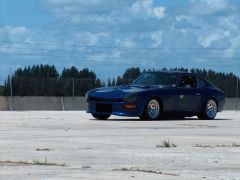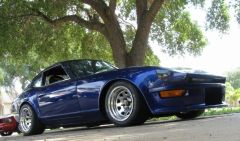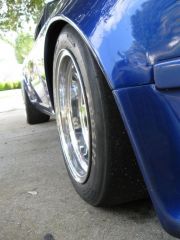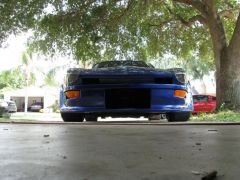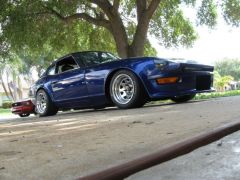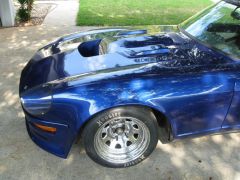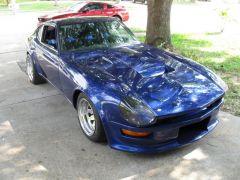-
Posts
1193 -
Joined
-
Last visited
-
Days Won
30
Content Type
Profiles
Forums
Blogs
Events
Gallery
Downloads
Store
Everything posted by 74_5.0L_Z
-
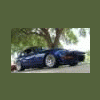
Front to rear weight ratio info wanted for 5.0
74_5.0L_Z replied to waddiejohn's topic in Ford V8Z Tech Board
If you are starting from scratch, here are two things that I would do differently: 1. Install the engine offset slightly to the passenger (right)side. My engine is centered left to right. This will help even out the left/right balance of the car and reduce the driveshaft angle (the nose of the differential is offset to the right). 2. Move the front crossmember forward ~1". This allows the sump of the oilpan to drop easily behind the crossmember and provides a significant caster increase. You can only really do this if you have camber plates installed. I would keep the front to rear and up and down position the same as I already have it. The driver's side head is 1" from the firewall, and the centerline of the crankshaft is even with the top of the front frame rails (at the front of the engine). Also the engine is installed at an angle of 2.5* (transmission tail lower than the nose of the crankshaft). -

Front to rear weight ratio info wanted for 5.0
74_5.0L_Z replied to waddiejohn's topic in Ford V8Z Tech Board
Here is a link where I discuss the weight distribution of my car and how it has changed with various modifications. http://forums.hybridz.org/showthread.php?t=92703&highlight=corner+weights -
If you search this forum the Ford driveshaft has been discussed several times. A couple of discussions included me. Here is a good link: http://forums.hybridz.org/showthread.php?t=75715&highlight=neapco
-

First impression of Formula Atlantic slicks
74_5.0L_Z replied to 74_5.0L_Z's topic in Brakes, Wheels, Suspension and Chassis
Just thought I would add my impressions of the FA slicks at the end of their useful life. When I first installed these I was impressed with their overall grip, but thought the slip angle would take some getting used to. Well, as the tires aged, the slip angles kept growing and the traction kept diminishing. This can be expected with any race tire as it ages. However, these tires go away quickly. All totalled, I got about 20 good runs, 20 mediocre runs, and about 10 runs that were scary as hell because I had no traction. For the price that I paid, I guess they worked well enough (I only paid $100.00 for a set of four). Next season, I will fork out the money for a new set of Hoosier A6 275/35/15 tires. The FA slicks are not in the same league as the Hoosier A6 tires for autocross. -

Wheel track measurement with Subtle Z
74_5.0L_Z replied to AkumaNoZeta's topic in Brakes, Wheels, Suspension and Chassis
As Dan Juday stated, "there are sevaral factor to consider" when designing the front track width for use with the SubtleZ front fenders. On mine, the front track is 66". I am using the FA slicks which are very short (22.9") mounted on 15x10 wheels. I posted pictures elsewhere to show how they fit and looked on the car. I'll post a few more here: At 66", it looks like I have a little bit of clearance at the front tires, but you need a little wiggle room to allow for suspension motion while the wheels are turned. -

Chassis Setup (corner weights)
74_5.0L_Z replied to 74_5.0L_Z's topic in Brakes, Wheels, Suspension and Chassis
My car is just approaching the minimum weight that I am likely to see based on the compromises that I am willing to make and the choices that I made. If I were willing to gut the doors and remove the dash, I could lose about 130 more pounds. If I had constructed the cage of 1.5 x 0.095 tubing rather than 1.625 x 0.120 tubing, I could have saved about 35 lbs. My custom front air dam and hood are heavier than simple fiberglass skins (My air dam with fan installed weighs 20 pounds). Replacing/ removing the glass is worth ~60 pounds. There are many other little gains that are beyond what I am willing to do. If minimum weight is important to you then start with an early 240Z shell. The later 260Z and 280Z shells are heavier. (Jon beat me to it) -

Chassis Setup (corner weights)
74_5.0L_Z replied to 74_5.0L_Z's topic in Brakes, Wheels, Suspension and Chassis
My car is pretty stripped. There is no carpet, undercoating, or sound deadening material. The center console, heater/AC, windshield wipers, and radio have all been removed. The stock seats have been replaced with Momo Start2007 fiberglass racing seats which are about 15 lbs lighter than stock. The battery has been replaced with an odessey PC680 which weighs a mere 15 lbs. I do have a pretty extensive cage in the car and an ATL 12 gallon fuel cell with steel can. The car also still has the full dash, all the interior plastic, and all of the glass installed. The car itself without me and fuel weighs 2350 lbs. To me that is pretty light. To get it very much lighter will require me to sacrifice the convenience of roll up windows (I could save 100 pounds by gutting the doors). -

First impression of Formula Atlantic slicks
74_5.0L_Z replied to 74_5.0L_Z's topic in Brakes, Wheels, Suspension and Chassis
My cables are set-up so that they are not adjustable. I used 1/8" multi-stranded cable, thimbles, and crimp connectors. The top is secured to the strut tower next to the spring using a clevis yoke, and the bottom is attached to the sway bar end link. I made the length of my droop limiter such that the spring is slightly loaded at full droop. My wife is out of town and has the camera, so I can't go out and take a picture. -

First impression of Formula Atlantic slicks
74_5.0L_Z replied to 74_5.0L_Z's topic in Brakes, Wheels, Suspension and Chassis
JustOlson asked, "Are you worried about scrapping the frame rail under hard turns? Looks like it was getting close before your switched to the shorter tires." I was a little concerned, but I had no problem while on course. My car doesn't roll nearly as much as it used to. Since then I have added a slightly stiffer front sway bar and droop limited the front suspension. I did have trouble coming on and off the track because there was a slight dip and my frame rails would scrape. Before the next event I plan to raise the front up a little bit by replacing the 450 lb/in springs with 500 lb/in springs. I may then move the 450 lb/in springs to the rear in place of my 425 lb/in springs that are currently installed. -

First impression of Formula Atlantic slicks
74_5.0L_Z replied to 74_5.0L_Z's topic in Brakes, Wheels, Suspension and Chassis
The front leading edge of my rocker panel is 4.25" off the ground, and the rear is 5". The center of my front crossmember is 2.75" off the ground, oil pan is 3", and the lowest point of my exhaust is 2.5". The lowest point however (the leading edge of my frame rail/ subframe connector) is 1.75" from the ground. Loading this thing on and off the trailer this past weekend was fun. I may have to lift it up a little. -

First impression of Formula Atlantic slicks
74_5.0L_Z replied to 74_5.0L_Z's topic in Brakes, Wheels, Suspension and Chassis
I am running the SubtleZ rear quarter panels, and the 23x9.5x15 tires fit well. The YZ rear quarter panels and the correct offset wheel will accommodate the larger 13.5 in wide rear FA slick (In hindsight, I sometimes wish that I had YZ rear Quarters). I bought the 15x10 wheels so that I would have the option of running the FA slick or running the 275/35/15 Hoosier A6 tires. I am willing to bet that my car would be faster on the latter of the two. The deciding factor for me right now is cost. A set of the A6 tires would run me $1100.00 and last for one racing season whether I use them or not (time kills them slowly). This year, I am not able to race as often as I did last year because I am back in school working on my masters degree in Mechanical Engineering, so a set of expensive, time-sensitive tires would be a waste. The used set of FA slicks cost me $108.00 shipped to my door. I figured if they work then great, and if they don't then I'm only out a few dollars. So far, I am quite happy with them. -

First impression of Formula Atlantic slicks
74_5.0L_Z replied to 74_5.0L_Z's topic in Brakes, Wheels, Suspension and Chassis
These are the radial FA tires. I bought directly from Spinwerkes. They were great to deal with, but their web-site definitely needs work. -

Chassis Setup (corner weights)
74_5.0L_Z replied to 74_5.0L_Z's topic in Brakes, Wheels, Suspension and Chassis
I have moved nearly everything that I can to the passenger side and as far back as possible (within the confines of the wheel base). The battery is behind the passenger seat, the radiator catch can is behind the right front wheel just ahead of the firewall and just off the ground, the fuel cell is 4" off center to the right. The coil, the computer, the mass air sensor and alternator are all on the right. I have lost some weight, but I fear that I can't lose much more without donating an organ. I am looking into a lighter steering column, lighter pedal assembly, and anything else that anyone could suggest. If I get really motivated, I will relocate the engine and transmission toward the passenger side by an inch. In the meantime, I look for passengers to ride along. They're usually pretty easy to find:burnout:. -

First impression of Formula Atlantic slicks
74_5.0L_Z replied to 74_5.0L_Z's topic in Brakes, Wheels, Suspension and Chassis
Here are some pictures showing the new Spinwerkes 15x10 wheels (5.25" backspace), and the new to me Hoosier 23.0 x 9.5 x 15 FA radial slicks. -
From the album: FA Slicks and Spinwerkes wheels
FA Slicks and Spinwerkes side -

FA Slicks and Spinwerkes wheels
Images added to a gallery album owned by 74_5.0L_Z in Members Albums
-
From the album: FA Slicks and Spinwerkes wheels
FA Slicks and Spinwerkes front low -
From the album: FA Slicks and Spinwerkes wheels
FA Slicks and Spinwerkes -
From the album: FA Slicks and Spinwerkes wheels
FA Slicks and Spinwerkes rear -
From the album: FA Slicks and Spinwerkes wheels
FA Slicks and Spinwerkes front -
From the album: FA Slicks and Spinwerkes wheels
FA Slicks and Spinwerkes -
From the album: FA Slicks and Spinwerkes wheels
FA Slicks and Spinwerkes -

First impression of Formula Atlantic slicks
74_5.0L_Z replied to 74_5.0L_Z's topic in Brakes, Wheels, Suspension and Chassis
I'll try to get some pictures of the car with the new wheels and tires and post them tomorrow. Drax the answer to your question is yes. They are less responsive and more forgiving, and I believe the overall grip was better. We'll have to see how they wear. Cary, by the end of the day I was driving as you stated, I had to "increase my steering input velocity." I really like the way they drove after I figured that out. BRAAP, the tires you had on the back of that car were just obscene:mrgreen:.

